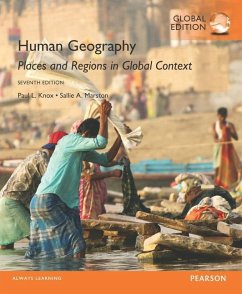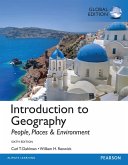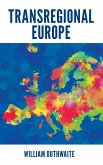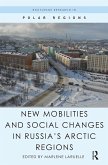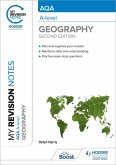For courses in Human Geography.
A distinctly modern look at human geography
Described as “fresh, innovative, and intelligent,” Human Geography: Places and Regions in Global Context is acclaimed for its global approach, conceptual rigor, engaging real-world applications, and outstanding visual program. Knox and Marston foster awareness of current issues and developing trends from a geographic perspective, and provide a solid foundation in the fundamentals of human geography.
The authors integrate compelling local, regional, and global viewpoints to give meaning to people and places. By providing access to the latest ideas, concepts, and theories, the text deepens students’ understanding of the interdependence of places and regions in a globalizing world. The Seventh Edition extends Knox/Marston’s modern approach, integrating new technology as well as new visual and thematic features relevant to human geography today.
MasteringGeography™ not included. Students, if MasteringGeography is a recommended/mandatory component of the course, please ask your instructor for the correct ISBN and course ID. MasteringGeography should only be purchased when required by an instructor. Instructors, contact your Pearson representative for more information.
MasteringGeography is an online homework, tutorial, and assessment product designed to personalize learning and improve results. With a wide range of interactive, engaging, and assignable activities, students are encouraged to actively learn and retain tough course concepts.
Features + Benefits
This title is a Pearson Global Edition. The Editorial team at Pearson has worked closely with educators around the world to include content, which is especially relevant to students outside the United States.
The ideal platform for all stages of your course
· Learning Management System (LMS) Integration provides seamless access to Mastering. We’ve made it easier to link from within your LMS to Mastering and provide solutions, regardless of your LMS platform. Learn more about LMS Integration .
· Mastering provides everything you need in an easy-to-use format. A rich and flexible set of pre-built courses and assignments get you started quickly. These assets can be used as is or customized to fit your specific teaching needs. The Calendar View on the course home page displays upcoming assignments and due dates, so you can easily stay organized.
· Mastering’s powerful gradebook records all scores for automatically graded assignments. Struggling students and challenging assignments are highlighted in red, giving you an at-a-glance view of potential hurdles in the course.
· Mastering’s diagnostics and insights provide unique insight into class and student performance. With a single click, you can view charts that summarize the most difficult problems, identify vulnerable students, and indicate grade distribution and score improvement over the duration of the course.
· Using data gathered from all of the students using the program, Mastering offers wrong-answer feedback that is specific to each student. Rather than simply providing feedback of the “right/wrong/try again” variety, Mastering guides students towards the correct final answer without giving the answer away.
· Mastering provides two types of hints that help students work through, and ultimately solve, problems. Declarative hints provide advice on how to approach the problem, guiding students to the final answer. Socratic hints break a problem down into smaller sub-problems, which makes it easier for students to complete the original problem.
· Mastering’s dynamic, best-in-class content is continually being improved based on data generated through classroom use, resulting in content that is driven by the performance of actual students. We make corrections to improve problems that have ambiguous answer choices, ineffectual detractors, or tricky language, and continue to strengthen each problem through ongoing review of the data generated by Mastering students.
A distinctly modern look at human geography gives meaning to people and places
NEW! A new organizational structure now includes standalone chapters on Cultural Geographies and Language, Communication, and Belief.
NEW! Chapter 6: Language, Communication, and Belief gives a better focus on how both language and religion reflect and influence societies, as well as how they spread around the world, and how they permeate politics and social life.
Several important themes are woven into every chapter:
Interdependence of people and places, especially the interactive relationships between the core and the periphery.
Social and cultural differences that are embedded in human geographies, especially the differences that relate to race, ethnicity, gender, age, and class.
The relationship between global processes and their local manifestations.
The continuing transformation of the political economy of the world system and nations, regions, cities, and localities.
UPDATED! A changing-world perspective takes a contemporary approach to human geography, reflecting many trends in the discipline. The Seventh Edition provides the most up-to-date coverage with amplified and integrated emphasis on the critical topics and themes of today:
Sustainability
Climate change
Gender
Place, space, and scale
Knox/Marston’s hallmark global framework:
Promotes a strong connection between topical and regional material by emphasizing how their processes are linked (e.g., technological innovation and the varying ways technology is adopted and modified by people and places).
Facilitates meaningful comparisons between people and places in different parts of the world, such as how the core-generated industrialization of agriculture shapes gender relations in households, both in the core and in the periphery.
Presents the relevant aspects of academic human geography (e.g., geopolitics and its role in the social construction of spaces and places).
UPDATED! A renewed focus on fundamentals gives students access not only to the new ideas, concepts, and theories that address the changes mentioned above, but also to the fundamentals of human geography: the principles, concepts, theoretical frameworks, and basic knowledge.
Chapter 1 focuses on basic introductory human geography content, allowing the text to be accessible to a wide range of intro courses and students.
Engaging real-world applications and graphics allow students to visualize a place or culture
UPDATED! The Visualizing Geography features consistently incorporate edgy, modern applications and visualizations of current spatial data. Highly visual, these interesting and challenging Infographics are unique, and set apart Knox/Marston’s visual program even further from other texts of its kind.
NEW! Spatial Inequality features highlight the growing imbalances and inequalities in today’s global society relative to the chapter’s major themes.
UPDATED! The reimagined Geography Matters features, authored by expert contributors from the community, present contemporary research and hot topics in geography subfields. Geography Matters show how geographers are using their unique tools and perspectives to solve contemporary real-world problems, emphasizing how geography and the geographic method matter in the world today.
UPDATED! The Future Geographies section at the end of each chapter emphasizes the modern, forward-looking appeal of this text, and increases “futures” content in context. Future Geographies now feature current projections and data and an Apply Your Knowledge feature so that students can put concepts into action.
Window on the World features take a key concept and explore its application in a particular location. This feature allows students to appreciate the relevance of geographic concepts to world events and brings far-flung places closer to their comprehension.
NEW! Data Analysis activities at the end of each chapter give students the chance to put their understanding of key themes in the chapter into practice.
The superior cartographic program consists of hundreds of rich, diverse, and fully updated maps to help professors better teach their students the important spatial elements inherent to human geography. In addition to the hundreds of maps that display meticulous attention to detail, the visual program includes:
Compound Figures that combine maps with 1. Geography Matters
2. The Changing Global Context
3. Geographies of Population and Migration
4. People and Nature
5. Cultural Geographies
6. Language, Communication, and Belief
7. Interpreting Places and Landscapes
8. Geographies of Economic Development
9. Geographies of Food and Agriculture
10. Political Geographies
11. Urbanization and the Global Urban System
12. City Spaces: Urban Structure
For courses in Human Geography. A distinctly modern look at human geography Described as ?fresh, innovative, and intelligent,? Human Geography: Places and Regions in Global Context is acclaimed for its global approach, conceptual rigor, engaging real-world applications, and outstanding visual program. Knox and Marston foster awareness of current issues and developing trends from a geographic perspective, and provide a solid foundation in the fundamentals of human geography. The authors integrate compelling local, regional, and global viewpoints to give meaning to people and places. By providing access to the latest ideas, concepts, and theories, the text deepens students' understanding of the interdependence of places and regions in a globalizing world. The Seventh Edition extends Knox/Marston's modern approach, integrating new technology as well as new visual and thematic features relevant to human geography today. MasteringGeography™ not included. Students, if MasteringGeography is a recommended/mandatory component of the course, please ask your instructor for the correct ISBN and course ID. MasteringGeography should only be purchased when required by an instructor. Instructors, contact your Pearson representative for more information. MasteringGeography is an online homework, tutorial, and assessment product designed to personalize learning and improve results. With a wide range of interactive, engaging, and assignable activities, students are encouraged to actively learn and retain tough course concepts.
A distinctly modern look at human geography
Described as “fresh, innovative, and intelligent,” Human Geography: Places and Regions in Global Context is acclaimed for its global approach, conceptual rigor, engaging real-world applications, and outstanding visual program. Knox and Marston foster awareness of current issues and developing trends from a geographic perspective, and provide a solid foundation in the fundamentals of human geography.
The authors integrate compelling local, regional, and global viewpoints to give meaning to people and places. By providing access to the latest ideas, concepts, and theories, the text deepens students’ understanding of the interdependence of places and regions in a globalizing world. The Seventh Edition extends Knox/Marston’s modern approach, integrating new technology as well as new visual and thematic features relevant to human geography today.
MasteringGeography™ not included. Students, if MasteringGeography is a recommended/mandatory component of the course, please ask your instructor for the correct ISBN and course ID. MasteringGeography should only be purchased when required by an instructor. Instructors, contact your Pearson representative for more information.
MasteringGeography is an online homework, tutorial, and assessment product designed to personalize learning and improve results. With a wide range of interactive, engaging, and assignable activities, students are encouraged to actively learn and retain tough course concepts.
Features + Benefits
This title is a Pearson Global Edition. The Editorial team at Pearson has worked closely with educators around the world to include content, which is especially relevant to students outside the United States.
The ideal platform for all stages of your course
· Learning Management System (LMS) Integration provides seamless access to Mastering. We’ve made it easier to link from within your LMS to Mastering and provide solutions, regardless of your LMS platform. Learn more about LMS Integration .
· Mastering provides everything you need in an easy-to-use format. A rich and flexible set of pre-built courses and assignments get you started quickly. These assets can be used as is or customized to fit your specific teaching needs. The Calendar View on the course home page displays upcoming assignments and due dates, so you can easily stay organized.
· Mastering’s powerful gradebook records all scores for automatically graded assignments. Struggling students and challenging assignments are highlighted in red, giving you an at-a-glance view of potential hurdles in the course.
· Mastering’s diagnostics and insights provide unique insight into class and student performance. With a single click, you can view charts that summarize the most difficult problems, identify vulnerable students, and indicate grade distribution and score improvement over the duration of the course.
· Using data gathered from all of the students using the program, Mastering offers wrong-answer feedback that is specific to each student. Rather than simply providing feedback of the “right/wrong/try again” variety, Mastering guides students towards the correct final answer without giving the answer away.
· Mastering provides two types of hints that help students work through, and ultimately solve, problems. Declarative hints provide advice on how to approach the problem, guiding students to the final answer. Socratic hints break a problem down into smaller sub-problems, which makes it easier for students to complete the original problem.
· Mastering’s dynamic, best-in-class content is continually being improved based on data generated through classroom use, resulting in content that is driven by the performance of actual students. We make corrections to improve problems that have ambiguous answer choices, ineffectual detractors, or tricky language, and continue to strengthen each problem through ongoing review of the data generated by Mastering students.
A distinctly modern look at human geography gives meaning to people and places
NEW! A new organizational structure now includes standalone chapters on Cultural Geographies and Language, Communication, and Belief.
NEW! Chapter 6: Language, Communication, and Belief gives a better focus on how both language and religion reflect and influence societies, as well as how they spread around the world, and how they permeate politics and social life.
Several important themes are woven into every chapter:
Interdependence of people and places, especially the interactive relationships between the core and the periphery.
Social and cultural differences that are embedded in human geographies, especially the differences that relate to race, ethnicity, gender, age, and class.
The relationship between global processes and their local manifestations.
The continuing transformation of the political economy of the world system and nations, regions, cities, and localities.
UPDATED! A changing-world perspective takes a contemporary approach to human geography, reflecting many trends in the discipline. The Seventh Edition provides the most up-to-date coverage with amplified and integrated emphasis on the critical topics and themes of today:
Sustainability
Climate change
Gender
Place, space, and scale
Knox/Marston’s hallmark global framework:
Promotes a strong connection between topical and regional material by emphasizing how their processes are linked (e.g., technological innovation and the varying ways technology is adopted and modified by people and places).
Facilitates meaningful comparisons between people and places in different parts of the world, such as how the core-generated industrialization of agriculture shapes gender relations in households, both in the core and in the periphery.
Presents the relevant aspects of academic human geography (e.g., geopolitics and its role in the social construction of spaces and places).
UPDATED! A renewed focus on fundamentals gives students access not only to the new ideas, concepts, and theories that address the changes mentioned above, but also to the fundamentals of human geography: the principles, concepts, theoretical frameworks, and basic knowledge.
Chapter 1 focuses on basic introductory human geography content, allowing the text to be accessible to a wide range of intro courses and students.
Engaging real-world applications and graphics allow students to visualize a place or culture
UPDATED! The Visualizing Geography features consistently incorporate edgy, modern applications and visualizations of current spatial data. Highly visual, these interesting and challenging Infographics are unique, and set apart Knox/Marston’s visual program even further from other texts of its kind.
NEW! Spatial Inequality features highlight the growing imbalances and inequalities in today’s global society relative to the chapter’s major themes.
UPDATED! The reimagined Geography Matters features, authored by expert contributors from the community, present contemporary research and hot topics in geography subfields. Geography Matters show how geographers are using their unique tools and perspectives to solve contemporary real-world problems, emphasizing how geography and the geographic method matter in the world today.
UPDATED! The Future Geographies section at the end of each chapter emphasizes the modern, forward-looking appeal of this text, and increases “futures” content in context. Future Geographies now feature current projections and data and an Apply Your Knowledge feature so that students can put concepts into action.
Window on the World features take a key concept and explore its application in a particular location. This feature allows students to appreciate the relevance of geographic concepts to world events and brings far-flung places closer to their comprehension.
NEW! Data Analysis activities at the end of each chapter give students the chance to put their understanding of key themes in the chapter into practice.
The superior cartographic program consists of hundreds of rich, diverse, and fully updated maps to help professors better teach their students the important spatial elements inherent to human geography. In addition to the hundreds of maps that display meticulous attention to detail, the visual program includes:
Compound Figures that combine maps with 1. Geography Matters
2. The Changing Global Context
3. Geographies of Population and Migration
4. People and Nature
5. Cultural Geographies
6. Language, Communication, and Belief
7. Interpreting Places and Landscapes
8. Geographies of Economic Development
9. Geographies of Food and Agriculture
10. Political Geographies
11. Urbanization and the Global Urban System
12. City Spaces: Urban Structure
For courses in Human Geography. A distinctly modern look at human geography Described as ?fresh, innovative, and intelligent,? Human Geography: Places and Regions in Global Context is acclaimed for its global approach, conceptual rigor, engaging real-world applications, and outstanding visual program. Knox and Marston foster awareness of current issues and developing trends from a geographic perspective, and provide a solid foundation in the fundamentals of human geography. The authors integrate compelling local, regional, and global viewpoints to give meaning to people and places. By providing access to the latest ideas, concepts, and theories, the text deepens students' understanding of the interdependence of places and regions in a globalizing world. The Seventh Edition extends Knox/Marston's modern approach, integrating new technology as well as new visual and thematic features relevant to human geography today. MasteringGeography™ not included. Students, if MasteringGeography is a recommended/mandatory component of the course, please ask your instructor for the correct ISBN and course ID. MasteringGeography should only be purchased when required by an instructor. Instructors, contact your Pearson representative for more information. MasteringGeography is an online homework, tutorial, and assessment product designed to personalize learning and improve results. With a wide range of interactive, engaging, and assignable activities, students are encouraged to actively learn and retain tough course concepts.

